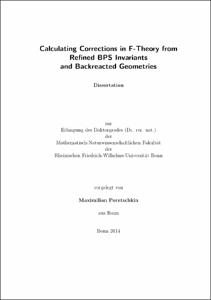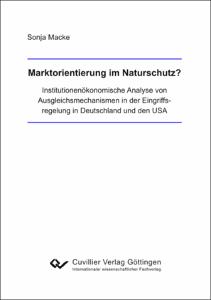Poretschkin, Maximilian: Calculating Corrections in F-Theory from Refined BPS Invariants and Backreacted Geometries. - Bonn, 2015. - Dissertation, Rheinische Friedrich-Wilhelms-Universität Bonn.
Online-Ausgabe in bonndoc: https://nbn-resolving.org/urn:nbn:de:hbz:5n-39690
Online-Ausgabe in bonndoc: https://nbn-resolving.org/urn:nbn:de:hbz:5n-39690
@phdthesis{handle:20.500.11811/6447,
urn: https://nbn-resolving.org/urn:nbn:de:hbz:5n-39690,
author = {{Maximilian Poretschkin}},
title = {Calculating Corrections in F-Theory from Refined BPS Invariants and Backreacted Geometries},
school = {Rheinische Friedrich-Wilhelms-Universität Bonn},
year = 2015,
month = mar,
note = {This thesis presents various corrections to F-theory compactifications which rely on the computation of refined Bogomol'nyi-Prasad-Sommerfield (BPS) invariants and the analysis of backreacted geometries.
Detailed information about rigid supersymmetric theories in five dimensions is contained in an index counting refined BPS invariants. These BPS states fall into representations of SU(2) x SU(2), the little group in five dimensions, which has an induced action on the cohomology of the moduli space of stable pairs.
In the first part of this thesis, we present the computation of refined BPS state multi-plicities associated to M-theory compactifications on local Calabi-Yau manifolds whose base is given by a del Pezzo or half K3 surface. For geometries with a toric realization we use an algorithm which is based on the Weierstrass normal form of the mirror geometry. In addition we use the refined holomorphic anomaly equation and the gap condition at the conifold locus in the moduli space in order to perform the direct integration and to fix the holomorphic ambiguity.
In a second approach, we use the refined Gottsche formula and the refined modular anomaly equation that govern the (refined) genus expansion of the free energy of the half K3 surface. By this procedure, we compute the refined BPS invariants of the half K3 from which the results of the remaining del Pezzo surfaces are obtained by flop transitions and blow-downs. These calculations also make use of the high symmetry of the del Pezzo surfaces whose homology lattice contains the root lattice of exceptional Lie algebras. In cases where both approaches are applicable, we successfully check the compatibility of these two methods.
In the second part of this thesis, we apply the results obtained from the calculation of the refined invariants of the del Pezzo respectively the half K3 surfaces to count non-perturbative objects in F-theory. The first application is given by BPS states of the E-String which are counted in the dual F-theory compactification. Using the refined BPS invariants we can count these states and explain their space-time spin content. In addition, we explain that they fall into representations of E8 which can be explicitly determined. The second application is given by a proposal how to count [p,q]-strings within F-theory which is based on the D3 probe-brane picture and the dual Seiberg-Witten description.
As a third contribution to F-theory which is independent of the results obtained in the first part, we consider the backreaction of G4-flux onto the geometry of a local model of a Calabi-Yau fourfold geometry. This induces a non-trivial warp-factor and modifies the Kaluza-Klein reduction ansatz. Taking this into account we demonstrate how corrections to the 7-brane gauge coupling function can be computed within F-theory.},
url = {https://hdl.handle.net/20.500.11811/6447}
}
urn: https://nbn-resolving.org/urn:nbn:de:hbz:5n-39690,
author = {{Maximilian Poretschkin}},
title = {Calculating Corrections in F-Theory from Refined BPS Invariants and Backreacted Geometries},
school = {Rheinische Friedrich-Wilhelms-Universität Bonn},
year = 2015,
month = mar,
note = {This thesis presents various corrections to F-theory compactifications which rely on the computation of refined Bogomol'nyi-Prasad-Sommerfield (BPS) invariants and the analysis of backreacted geometries.
Detailed information about rigid supersymmetric theories in five dimensions is contained in an index counting refined BPS invariants. These BPS states fall into representations of SU(2) x SU(2), the little group in five dimensions, which has an induced action on the cohomology of the moduli space of stable pairs.
In the first part of this thesis, we present the computation of refined BPS state multi-plicities associated to M-theory compactifications on local Calabi-Yau manifolds whose base is given by a del Pezzo or half K3 surface. For geometries with a toric realization we use an algorithm which is based on the Weierstrass normal form of the mirror geometry. In addition we use the refined holomorphic anomaly equation and the gap condition at the conifold locus in the moduli space in order to perform the direct integration and to fix the holomorphic ambiguity.
In a second approach, we use the refined Gottsche formula and the refined modular anomaly equation that govern the (refined) genus expansion of the free energy of the half K3 surface. By this procedure, we compute the refined BPS invariants of the half K3 from which the results of the remaining del Pezzo surfaces are obtained by flop transitions and blow-downs. These calculations also make use of the high symmetry of the del Pezzo surfaces whose homology lattice contains the root lattice of exceptional Lie algebras. In cases where both approaches are applicable, we successfully check the compatibility of these two methods.
In the second part of this thesis, we apply the results obtained from the calculation of the refined invariants of the del Pezzo respectively the half K3 surfaces to count non-perturbative objects in F-theory. The first application is given by BPS states of the E-String which are counted in the dual F-theory compactification. Using the refined BPS invariants we can count these states and explain their space-time spin content. In addition, we explain that they fall into representations of E8 which can be explicitly determined. The second application is given by a proposal how to count [p,q]-strings within F-theory which is based on the D3 probe-brane picture and the dual Seiberg-Witten description.
As a third contribution to F-theory which is independent of the results obtained in the first part, we consider the backreaction of G4-flux onto the geometry of a local model of a Calabi-Yau fourfold geometry. This induces a non-trivial warp-factor and modifies the Kaluza-Klein reduction ansatz. Taking this into account we demonstrate how corrections to the 7-brane gauge coupling function can be computed within F-theory.},
url = {https://hdl.handle.net/20.500.11811/6447}
}









